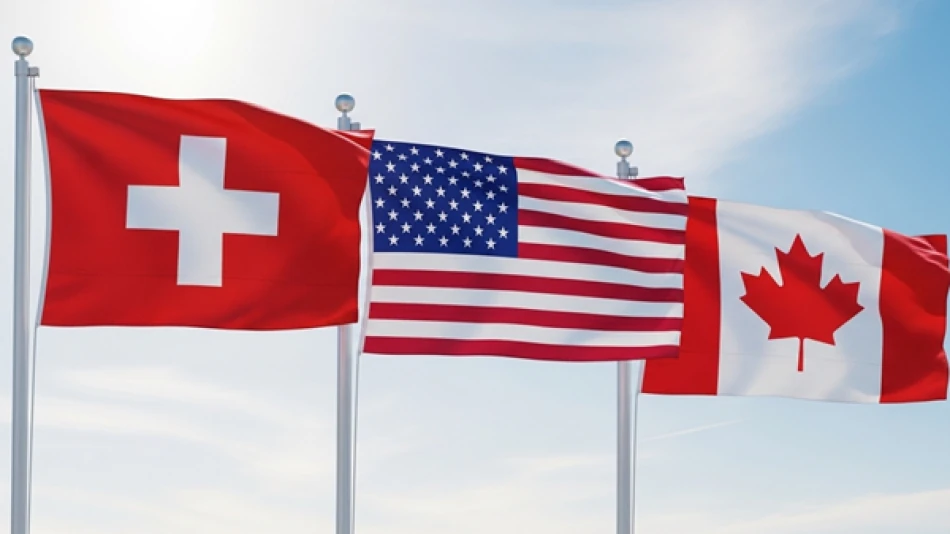
Trump Imposes Sweeping Tariffs on Canada and Switzerland, Escalating Trade Tensions
Trump's Sweeping Tariff Blitz Reshapes Global Trade as Canada and Switzerland Bear the Brunt
President Donald Trump signed a sweeping executive order Thursday evening imposing new tariffs on dozens of countries, marking the most aggressive trade restructuring since World War II. The move, which takes effect August 7th, hits Switzerland with a punishing 39% rate and escalates Canadian tariffs to 35%, while offering more favorable terms to negotiating partners like the EU and Japan. Financial markets immediately responded with European stocks opening lower Friday, signaling investor concern over the return of protectionist policies that could reshape decades of international trade norms.
A Calculated Departure from Post-War Trade Order
The tariff structure reveals a sophisticated diplomatic strategy rather than blanket protectionism. While Syria faces the highest rates at 41% and Laos at 40%, Trump's administration offered significantly reduced tariffs to countries that engaged in negotiations: 15% for EU, Japan, and South Korea products, and just 10% for UK goods with sector-specific exemptions.
Wendy Cutler, deputy director of the Asia Society Policy Institute, characterized these decisions as departing from "the rules that have governed international trade since World War II." This assessment underscores how Trump's approach fundamentally challenges the multilateral trade framework established through institutions like the WTO.
Market Impact and Economic Ripple Effects
Financial markets provided an immediate verdict on the policy shift. European bourses opened in negative territory Friday, while Asian markets closed with modest declines. The measured response suggests investors are still processing the full implications, though economists warn of broader consequences including restricted trade flows, higher production costs, and inflationary pressure.
Interestingly, the International Monetary Fund appeared less pessimistic than in previous forecasts, possibly reflecting expectations that targeted tariffs may prove less disruptive than the blanket trade wars of Trump's first term.
Switzerland and Canada: Unexpected Casualties
Switzerland's 39% tariff rate exceeded Washington's earlier hints of 31%, catching Swiss officials off-guard. The Alpine nation's export portfolio—pharmaceuticals, luxury watches, cheese, and chocolate—faces significant headwinds in its crucial American market. Swiss authorities expressed disappointment while emphasizing their commitment to finding negotiated solutions.
Canada's situation proves equally challenging, with tariffs on certain products jumping from 25% to 35%. Prime Minister Mark Carney responded by urging increased domestic consumption and export market diversification—a strategy that could accelerate Canada's pivot toward Asian markets, particularly given its CPTPP membership.
Strategic Exemptions and Diplomatic Messaging
The tariff structure reveals clear diplomatic priorities. Mexico received a 90-day grace period, reflecting ongoing USMCA considerations. Brazil faces 50% tariffs with limited exceptions, ostensibly linked to legal proceedings against former President Jair Bolsonaro—demonstrating how domestic political issues increasingly intersect with trade policy.
China labeled the measures "protectionist" while continuing negotiations to extend the current trade truce through August 12th. This suggests both sides recognize the economic stakes involved, even as they prepare for renewed confrontation.
Implications for Global Trade Architecture
Trump's tariff strategy appears designed to fracture the multilateral trading system in favor of bilateral negotiations where U.S. leverage proves greater. Countries receiving preferential rates—those that negotiated—may encourage other nations to seek direct deals with Washington rather than relying on WTO dispute mechanisms.
This approach could accelerate the formation of competing trade blocs, with excluded countries potentially strengthening alternative frameworks like the Regional Comprehensive Economic Partnership (RCEP) or expanding South-South trade relationships.
The New Economics of Trade Diplomacy
The August 7th implementation date provides breathing room for both U.S. customs authorities and affected countries to adjust. However, the differentiated tariff structure suggests this represents a permanent shift rather than temporary negotiating pressure.
For investors and multinational corporations, the message is clear: trade relationships now depend more on political negotiations than economic fundamentals. Companies may need to restructure supply chains based on diplomatic relationships rather than purely cost considerations—a trend that could reshape global manufacturing patterns for years to come.
Most Viewed News

 Layla Al Mansoori
Layla Al Mansoori






